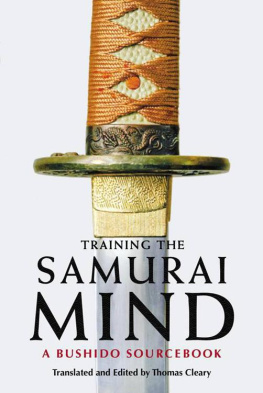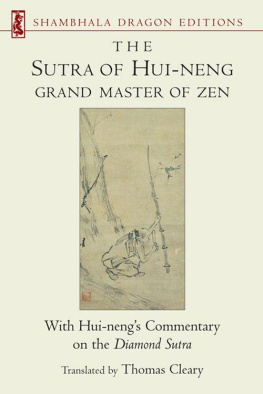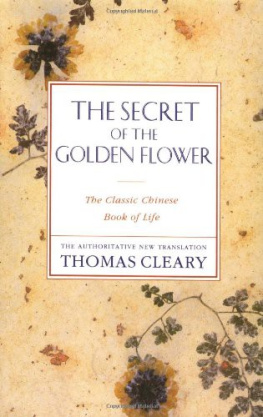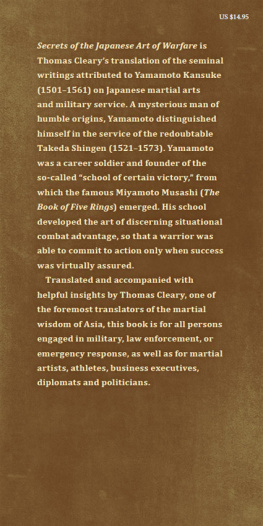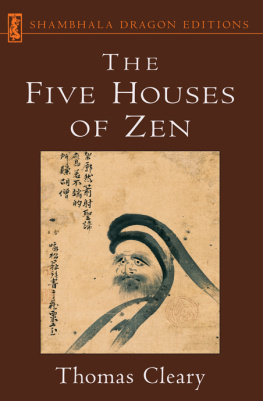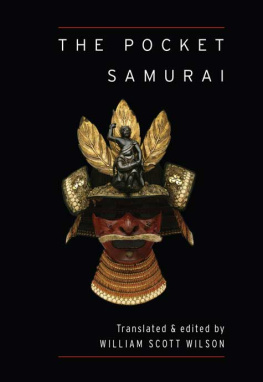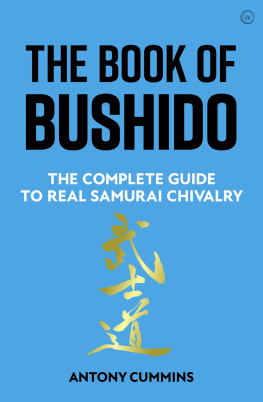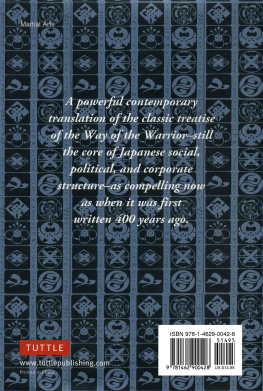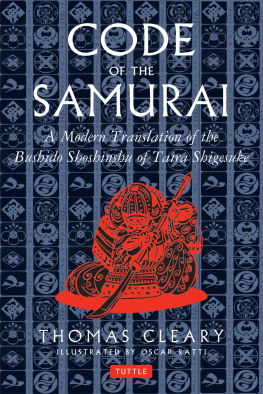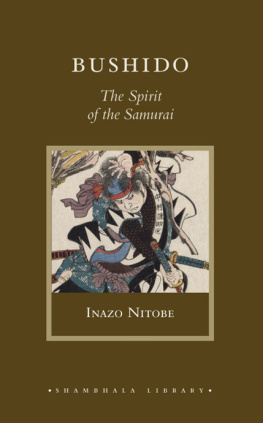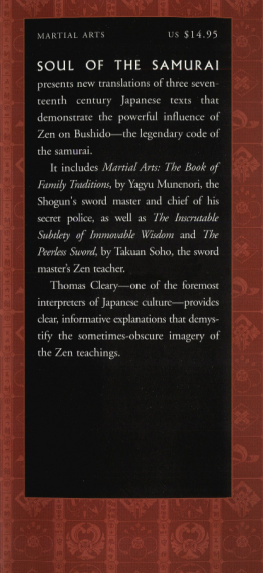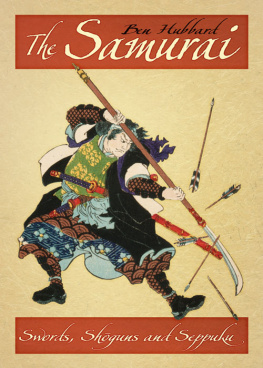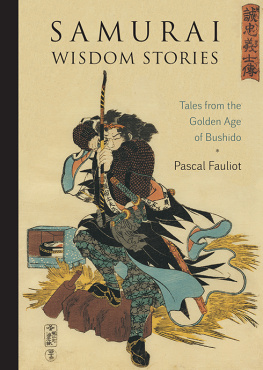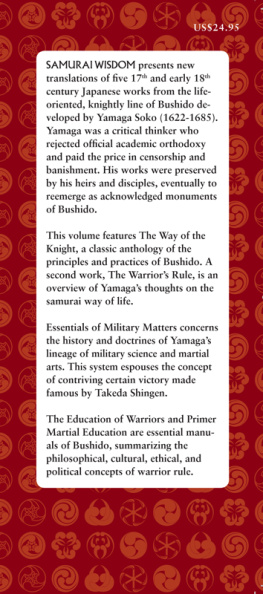TRAINING THE
SAMURAI MIND
A BUSHIDO SOURCEBOOK
Translated and Edited by Thomas Cleary


SHAMBHALA
Boston & London 2011
SHAMBHALA PUBLICATIONS, INC.
Horticultural Hall
300 Massachusetts Avenue
Boston, Massachusetts 02115
www.shambhala.com
2008 by Thomas Cleary
All rights reserved. No part of this book may be reproduced in any form or by any means, electronic or mechanical, including photocopying, recording, or by any information storage and retrieval system, without permission in writing from the publisher.
The Library of Congress catalogues the hardcover edition of this book as follows:
Training the samurai mind: a bushido sourcebook / edited by Thomas Cleary.
p. cm.
eISBN 978-0-8348-2308-2
ISBN 978-1-59030-572-0 (hardcover: alk. paper)
ISBN 978-1-59030-721-2 (paperback: alk. paper)
1. Bushido. 2. SamuraiConduct of life. I. Cleary, Thomas F., 1949
BJ971.B8T73 2008
170.440952dc22
2007041865
CONTENTS
The caste and culture of the professional warriors of traditional Japan, best known to the West by the term samurai, developed over many centuries of historical change, ultimately to seize and sustain the position of dominant paradigm in Japanese society for seven hundred years. The culture of the samurai, incorporating elements of Taoism, Confucianism, Buddhism, and Shinto, along with the martial arts and military science essential to their original profession, came to be referred to as budo, the warriors way; or shido, the knights way; and finally bushido, the way of the warrior-knight.
Military culture has an ancient history in Japan, albeit one told in different terms according to the tradition of the telling. The imperial Shinto version, while relating to the earliest strata of Japanese legend and history, is the latest theme to emerge as a central feature in bushido ideology. While Shinto had by this time been influenced by centuries of contact with various elements of Confucianism, Buddhism, and Taoism, the militarized imperial Shinto revival in bushido began in some sense by attacking these very traditions.
Confucianism, originally associated with the establishment of a centralized state on the Chinese model, was reintroduced in new forms by Zen Buddhists in the thirteenth century, patronized by newly ascendant warrior chiefs. Emerging as an independent intellectual movement in the late sixteenth century, Confucianism was promoted by Japanese warlords as a means of civilizing the samurai. In one sense, this meant to prepare educated military personnel for peacetime administration of civil affairs as masters of the land. Civilization in the Confucian sense also meant to induce professional warriors to internalize a structure of subordination, including subordination of self-interest to public interest, in order to sustain social order and obviate perpetual power struggles among men at arms.
Taoism has had a more diffuse history in Japan than the other main intellectual imports, Confucianism and Buddhism, never having been institutionalized in any comparable way. It is probable, nonetheless, that the sort of Taoism ostensibly associated with the quest for immortality reached Japan by the end of the third century B.C.E ., with sea expeditions sent eastward by the First Emperor of China, or with refugees from the same emperors regime, or perhaps with both categories of people.
Other elements of ancient Taoism, practices commonly called magical or shamanic, seem to have entered Japan earlier, from both China and Korea. Taoist shamanism seems to have merged with its Shinto counterparts in Japan, particularly after being legally banned in the eighth century. Shamanic Taoism of the so-called Left-Hand Path, a sinister appellation also applied to an element of Tantric Buddhism, includes methods of demonic or magical warfare, brandishing destructive techniques based on mental or physical poisoning. This left-hand path, amalgamated with Shinto and Buddhist analogues, underlay the evolution of the lore of the ninja assassin. Events of ambiguous reality emerging from this tradition often mirror tactical use of insidious suggestion to cast enemies into states of mental terror.
Taoist political philosophy and psychology appear to have entered Japan later than the shamanic and immortalist elements, being brought along with the massive importation of Chinese literature and technology into Japan beginning in the seventh century. For the purposes of bushido theorists, both in combat and in administration, the political, economic, and psychological theories of Taoism were essentially embodied in techniques of command and control, military tactics, and martial arts. Many of the most prominent samurai military scientists were steeped in Taoist-influenced Chinese strategic classics such as Sun Wus The Art of War.
As the modern era approached and the sense of being surrounded by hostile powers spurred the development of a distinctly Shinto brand of bushido, some military thinkers in Japan began to repudiate the Taoist model of responsive action versus aggressive initiative, advocating the latter as more characteristic of the real history of Japanese warfare and more practical for Japans true situation, as they saw it, in the international context. In tactical terms, the international military operations of the nineteenth and twentieth centuries under imperial command drew heavily on this latter Shinto conception of a native Japanese way of war.
Various techniques of both individual and mass combat advocated by more classical-minded bushido military thinkers of premodern times are informed by Taoist principles reflecting a general Taoist strategy of minimalism and essentialism. Another expression of this strategy that was incorporated into bushido is the samurai ethos of austerity. In both civil and military roles, austerity is often emphasized in bushido as an economic strategy for home and state as well as a mode of tempering and training the individual warrior.
This sort of pragmatic minimalism forms an element of Taoist political philosophy as well as a martial custom of perpetual preparedness. In addition, Buddhist asceticism and its less radical Confucian counterpart also played an important role in the rationalization of the austerity of bushido, particularly after the end of endemic warfare and the establishment of national peace and order in the seventeenth century eliminated immediate consciousness of the need for austerity on the part of the ruling warlords and their knights.
Like Taoism, if later in time, Buddhism originally entered Japan with immigrants from China and Korea. Buddhism was eventually to become a political factor in the sixth century, when emblematic artifacts were sent to the Japanese court by the king of Paekche on the Korean peninsula. As it happened, the implications of this diplomatic mission in terms of international trade, military alliance, and domestic political patronage precipitated a conflict between powerful Japanese clan factions. This dispute ultimately resulted in the vanquishing and dissolution of the redoubtable Mononobe military clan, a historical ally of the imperial clan with intrinsically Shinto roots, who opposed the adoption of Buddhism at the imperial court.
Buddhism was ultimately established as a sort of state religion by the first historical Japanese constitution of 604, attributed to the celebrated Prince Shotoku. The second article of this famous document says, Earnestly respect the Three Treasures. The Three Treasures are Buddha, Dharma, and Sangha. These are the ultimate refuge for all forms of life, the supreme religion of myriad nations. Who in what era has not valued this teaching? People are rarely very bad, and can be taught to follow it. If they do not take refuge in the Three Treasures, by what means can the crooked be straightened?
Next page
